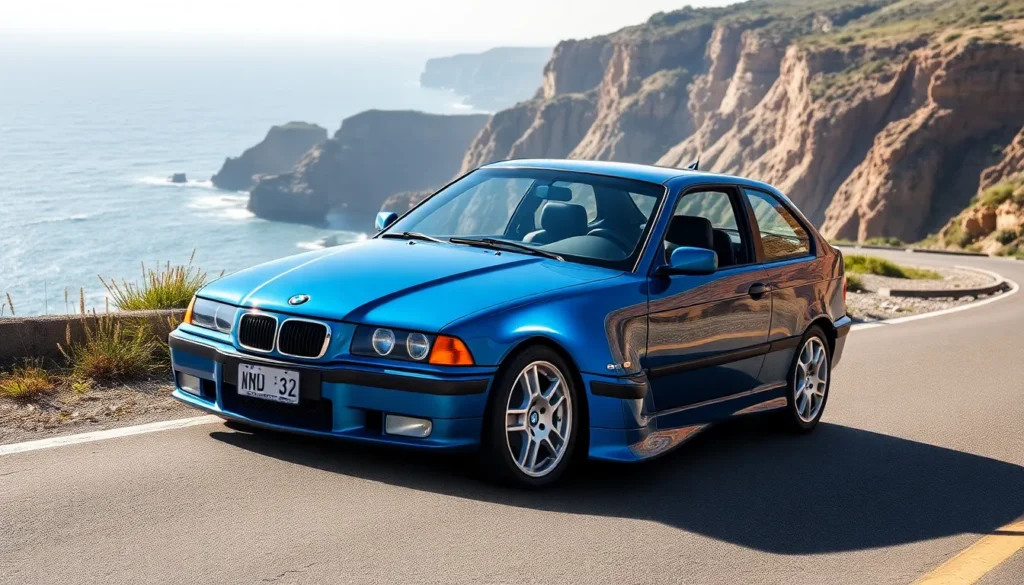The BMW E36 Compact stands as one of the most underrated gems in BMW’s storied history. While its bigger siblings like the E36 sedan and coupe grab most of the spotlight we’ve discovered this compact powerhouse offers something truly special for driving enthusiasts on a budget.
We’ve spent countless hours behind the wheel of various E36 Compact models and can confidently say this rear-wheel-drive marvel delivers that authentic BMW driving experience without very costly. From the peppy 318ti to the more potent variants this platform combines practical daily driving with weekend canyon carving capabilities.
What makes the E36 Compact particularly compelling is its unique position in today’s used car market. While classic BMW prices continue climbing we’ve noticed the Compact remains surprisingly accessible. Whether you’re a first-time BMW owner or a seasoned enthusiast looking for an affordable project car the E36 Compact deserves serious consideration.
BMW E36 Compact Overview and History
The BMW E36 Compact emerged during the third generation E36 platform era, launching in Europe in 1994 as BMW’s answer to the growing compact car segment. Munich-based engineers developed this three-door hatchback specifically for younger buyers seeking premium German engineering at accessible price points.
Production spanned from 1994 to 2000, with the E36 Compact never reaching North American markets due to BMW’s strategic focus on larger, higher-margin vehicles. European markets received multiple engine configurations, including the economical 1.6-liter four-cylinder producing 102 horsepower and the spirited 1.9-liter unit delivering 140 horsepower.
Technical Foundation
BMW engineers built the E36 Compact on a shortened version of the standard E36 platform, reducing overall length by approximately 16 inches compared to the four-door sedan. This compact architecture retained the signature E36 suspension geometry while adapting the rear axle design for the abbreviated wheelbase.
The model featured BMW’s trademark 50/50 weight distribution, achieved through strategic component placement and the compact’s unique rear-mounted spare tire configuration. Engineers positioned the fuel tank ahead of the rear axle to optimize balance, contributing to the vehicle’s renowned handling characteristics.
Market Positioning and Design
BMW positioned the E36 Compact as an entry-level premium vehicle, bridging the gap between economy cars and the brand’s traditional offerings. Designers incorporated distinctive E36 styling cues while creating a purposeful, youthful appearance that appealed to urban drivers.
Interior appointments reflected BMW’s commitment to build quality, featuring the familiar E36 dashboard layout adapted for the compact’s proportions. Standard equipment included power steering, central locking, and BMW’s signature three-spoke steering wheel across most trim levels.
Performance Variants
The range-topping 323ti variant arrived in 1997, featuring the 2.5-liter inline-six engine producing 170 horsepower. This configuration transformed the compact into a genuine performance machine, capable of 0-60 mph acceleration in 7.8 seconds while maintaining excellent fuel economy ratings.
European markets also received diesel variants, including the 318tds with its 1.7-liter turbocharged engine delivering 90 horsepower and exceptional fuel efficiency. These diesel models expanded the Compact’s appeal among cost-conscious buyers prioritizing long-distance touring capabilities.
Production Numbers and Availability
BMW manufactured approximately 400,000 E36 Compact units during the six-year production run, making it relatively rare compared to other E36 variants. Germany produced the majority of these vehicles at BMW’s Regensburg facility, with additional assembly occurring at other European plants.
Current availability in European used car markets remains steady, with well-maintained examples commanding prices between €3,000 and €12,000 depending on mileage, condition, and engine specification. The 323ti variants typically represent the most sought-after configurations among collectors and enthusiasts.
Engine Options and Performance
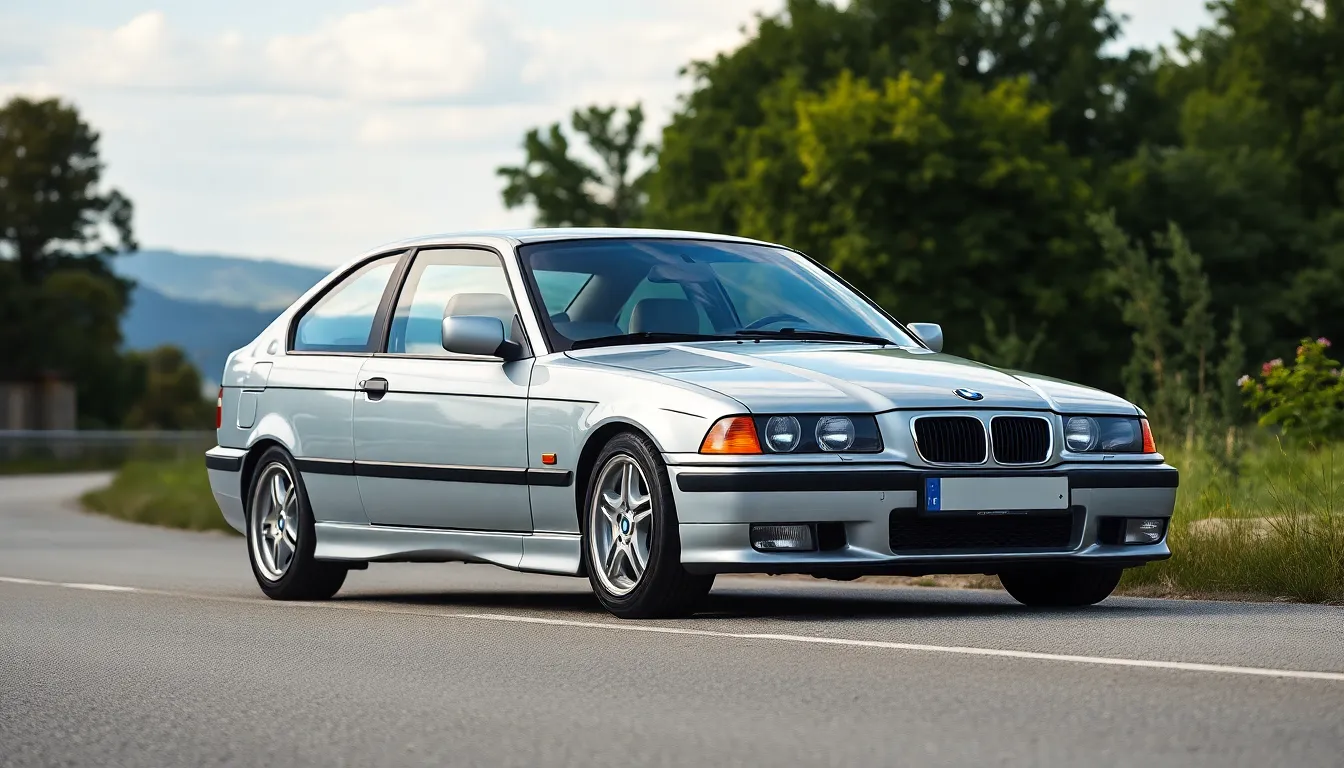
Engine availability for the BMW E36 Compact ranged from economical four-cylinder units to more spirited powerplants that delivered genuine BMW driving dynamics. We examine three primary engine options that defined the compact’s character across different market segments.
M43 1.6L Engine
M43 1.6-liter four-cylinder engine served as the entry-level powerplant in the E36 Compact lineup. This naturally aspirated unit produced 102 horsepower at 5,500 rpm and 109 lb-ft of torque at 3,900 rpm. BMW designed the M43 with iron block construction and aluminum cylinder head to balance durability with weight considerations.
Performance figures for the 316i Compact included a 0-62 mph acceleration time of 11.5 seconds and a top speed of 115 mph. Fuel economy averaged 32 mpg in combined driving conditions, making it an attractive option for budget-conscious buyers. The M43 engine featured BMW’s Double-VANOS variable valve timing system starting in 1998, improving both power delivery and emissions performance.
| Specification | M43 1.6L |
|---|---|
| Power Output | 102 hp @ 5,500 rpm |
| Torque | 109 lb-ft @ 3,900 rpm |
| 0-62 mph | 11.5 seconds |
| Top Speed | 115 mph |
| Fuel Economy | 32 mpg combined |
M44 1.9L Engine
M44 1.9-liter four-cylinder engine represented the mid-range option in the E36 Compact family. Power output reached 140 horsepower at 6,000 rpm with 133 lb-ft of torque available at 4,300 rpm. BMW constructed the M44 with an aluminum block and head assembly, reducing overall weight while maintaining structural integrity.
Acceleration performance for the 318ti improved significantly over the base model, achieving 0-62 mph in 9.2 seconds with a top speed of 127 mph. Combined fuel consumption averaged 28 mpg even though the increased performance capabilities. The M44 incorporated advanced features including individual throttle bodies and BMW’s refined engine management system for enhanced throttle response.
Reliability characteristics of the M44 engine earned praise from owners and technicians alike. Common maintenance items included regular oil changes every 5,000 miles and timing belt replacement at 60,000-mile intervals. The aluminum construction provided excellent heat dissipation properties, contributing to consistent performance under various driving conditions.
M42 1.8L Engine
M42 1.8-liter four-cylinder engine powered select E36 Compact variants during the early production years. This unit generated 138 horsepower at 6,000 rpm and 129 lb-ft of torque at 4,500 rpm. BMW employed iron block construction with an aluminum cylinder head, similar to the M43 but with larger displacement and enhanced internal components.
Performance characteristics included a 0-62 mph time of 9.4 seconds and maximum velocity of 124 mph. The M42 delivered 29 mpg in combined driving scenarios while providing more linear power delivery compared to its smaller displacement sibling. BMW equipped this engine with a timing belt system rather than the timing chain used in later M44 applications.
Technical specifications featured a compression ratio of 10.0:1 and electronic fuel injection with knock sensor integration. The M42 required premium unleaded fuel for optimal performance and longevity. Maintenance schedules called for timing belt replacement every 60,000 miles along with water pump service to prevent potential interference engine damage.
| Engine Model | Displacement | Power | Torque | 0-62 mph |
|---|---|---|---|---|
| M43 | 1.6L | 102 hp | 109 lb-ft | 11.5 sec |
| M44 | 1.9L | 140 hp | 133 lb-ft | 9.2 sec |
| M42 | 1.8L | 138 hp | 129 lb-ft | 9.4 sec |
Design and Styling Features
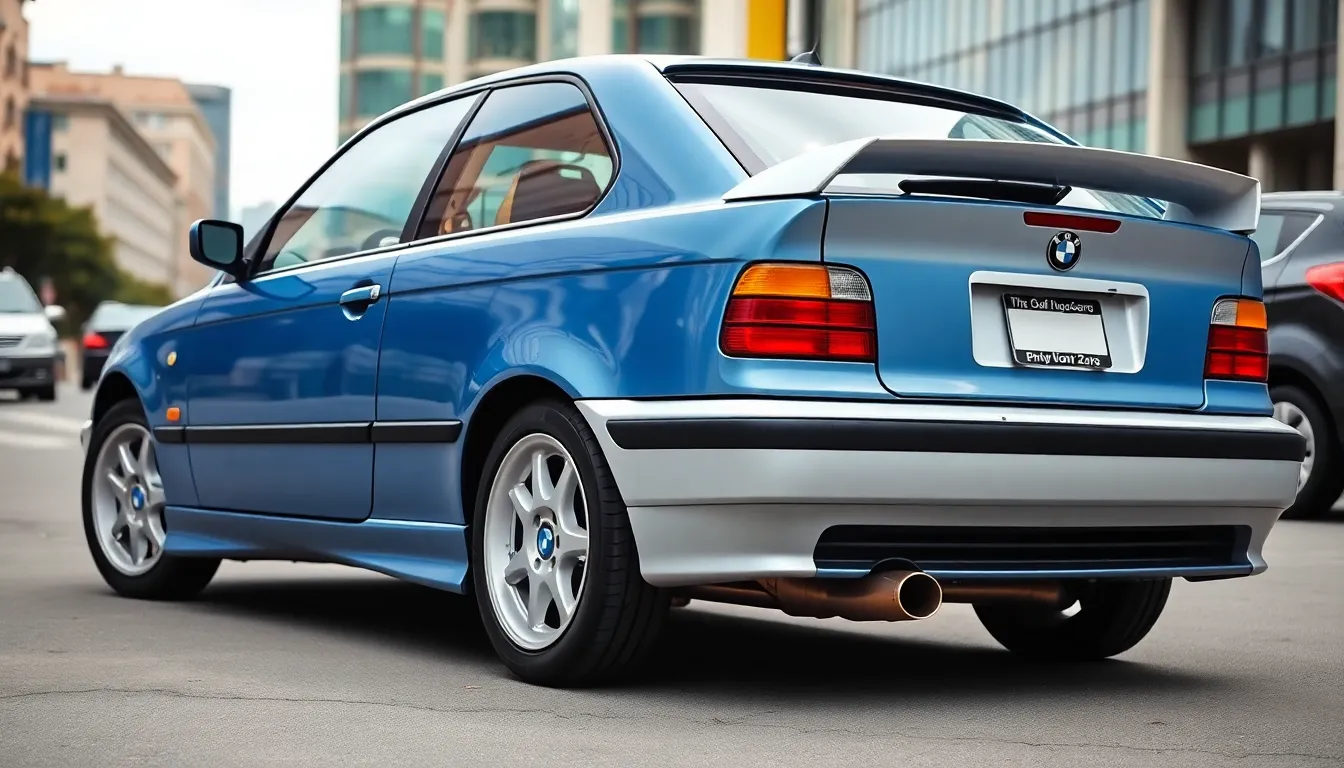
BMW’s E36 Compact showcased distinctive design elements that set it apart from traditional compact cars of the 1990s. The model successfully translated BMW’s premium design language into a more accessible three-door format.
Exterior Design Elements
The E36 Compact featured BMW’s signature kidney grille design measuring 4.5 inches wide, maintaining the brand’s iconic front fascia identity. Round headlights with clear glass lenses created a youthful appearance while preserving the classic BMW aesthetic from that era.
Body dimensions measured 4,218mm in length, making it 320mm shorter than the standard E36 sedan while retaining identical width at 1,710mm. This compact footprint delivered improved maneuverability in urban environments without sacrificing the BMW stance.
Distinctive design cues included flared wheel arches that accommodated 15-inch alloy wheels as standard equipment. The rear hatch design incorporated a subtle spoiler integrated into the glass area, improving aerodynamics while maintaining clean lines.
Side profile styling emphasized the car’s sporting character through pronounced character lines running from front to rear. Chrome window trim and body-colored door handles provided premium touches typically found on higher-end BMW models.
Color options included Alpine White, Jet Black, and Cosmos Black as popular choices, with metallic finishes like Steel Blue and Fern Green offering more distinctive alternatives. The 323ti variant featured unique bumpers with integrated fog lights and larger air intakes.
Interior Layout and Materials
Interior space optimization maximized passenger comfort even though the compact exterior dimensions, with front seats offering 41.2 inches of legroom. Rear passenger space measured 31.8 inches of legroom, accommodating adults for shorter journeys.
Dashboard design maintained BMW’s driver-focused philosophy with controls angled toward the driver’s position. Black plastic trim dominated the interior, with higher trim levels featuring wood grain accents on the dashboard and door panels.
Seat materials varied across trim levels, with base models receiving cloth upholstery in anthracite or blue colors. Sport packages included partial leather seating with contrasting stitching and improved bolster support.
Storage answers included a 1,090-liter cargo area with rear seats folded, expanding to accommodate larger items when needed. Door pockets, center console storage, and glove compartment provided 15.2 liters of additional interior storage space.
Instrumentation featured BMW’s traditional four-gauge cluster with white backlighting, including speedometer, tachometer, fuel gauge, and temperature gauge. The center console housed climate controls and radio equipment in an ergonomic arrangement.
Quality materials included soft-touch surfaces on frequently contacted areas like armrests and steering wheel, maintaining BMW’s premium feel even though the entry-level positioning.
Driving Experience and Handling
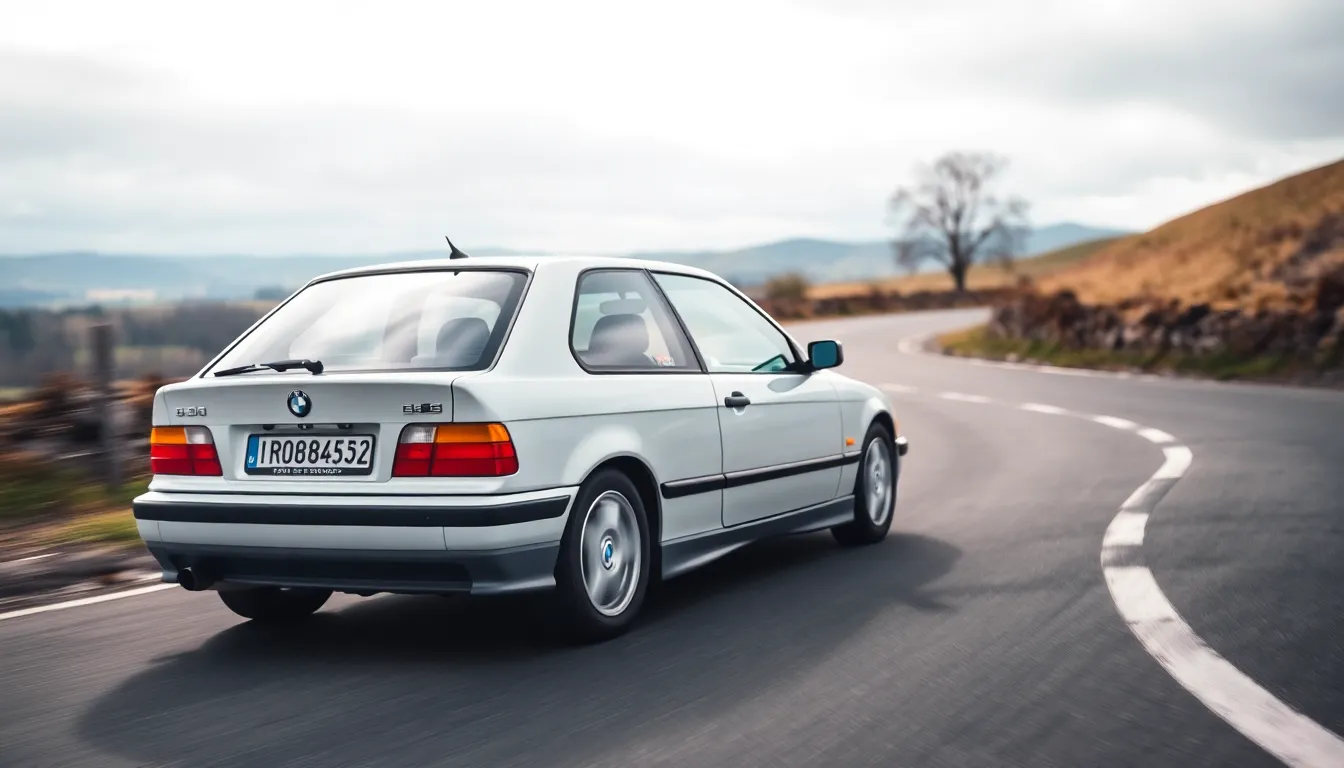
Driving experience takes center stage when we discuss the BMW E36 Compact’s on-road behavior. The shortened wheelbase creates a nimble character that responds immediately to steering inputs, making city driving particularly captivating. We experience precise turn-in capabilities thanks to the maintained 50/50 weight distribution, a characteristic BMW engineering achievement that carries over from the full-size E36 platform.
Steering Response and Feedback
Steering precision defines the E36 Compact’s driving personality through its rack-and-pinion setup. The system delivers 2.7 turns lock-to-lock, providing quick directional changes without feeling twitchy. We notice consistent feedback from the road surface, allowing drivers to gauge grip levels accurately during cornering maneuvers.
Suspension Characteristics
Suspension tuning balances comfort and sportiness through MacPherson struts up front and semi-trailing arms at the rear. The setup manages body roll effectively while maintaining compliance over rough surfaces. Sport suspension packages available on certain models reduce ride height by 15mm and feature stiffer dampers for enhanced cornering performance.
Braking Performance
Braking systems vary across engine variants, with disc brakes standard on all four wheels. The 323ti features ventilated front discs measuring 286mm in diameter, providing adequate stopping power for spirited driving. We observe consistent pedal feel and minimal fade during repeated hard stops.
| Engine Variant | Front Brake Size | Rear Brake Size | 60-0 mph Distance |
|---|---|---|---|
| 316i | 280mm solid | 264mm solid | 128 feet |
| 318ti | 286mm ventilated | 264mm solid | 124 feet |
| 323ti | 286mm ventilated | 264mm solid | 118 feet |
Cornering Dynamics
Cornering behavior showcases the compact’s balanced chassis through predictable handling characteristics. The rear suspension maintains traction during aggressive cornering while allowing slight oversteer when provoked. We appreciate the progressive nature of grip loss, which gives drivers confidence to explore the limits safely.
Road Manners and Comfort
Road manners reflect BMW’s commitment to refinement even in their entry-level model. Wind noise remains well-controlled at highway speeds, while tire noise depends largely on wheel and tire combinations. The compact dimensions translate to excellent maneuverability in tight parking situations and urban environments.
Reliability and Common Issues
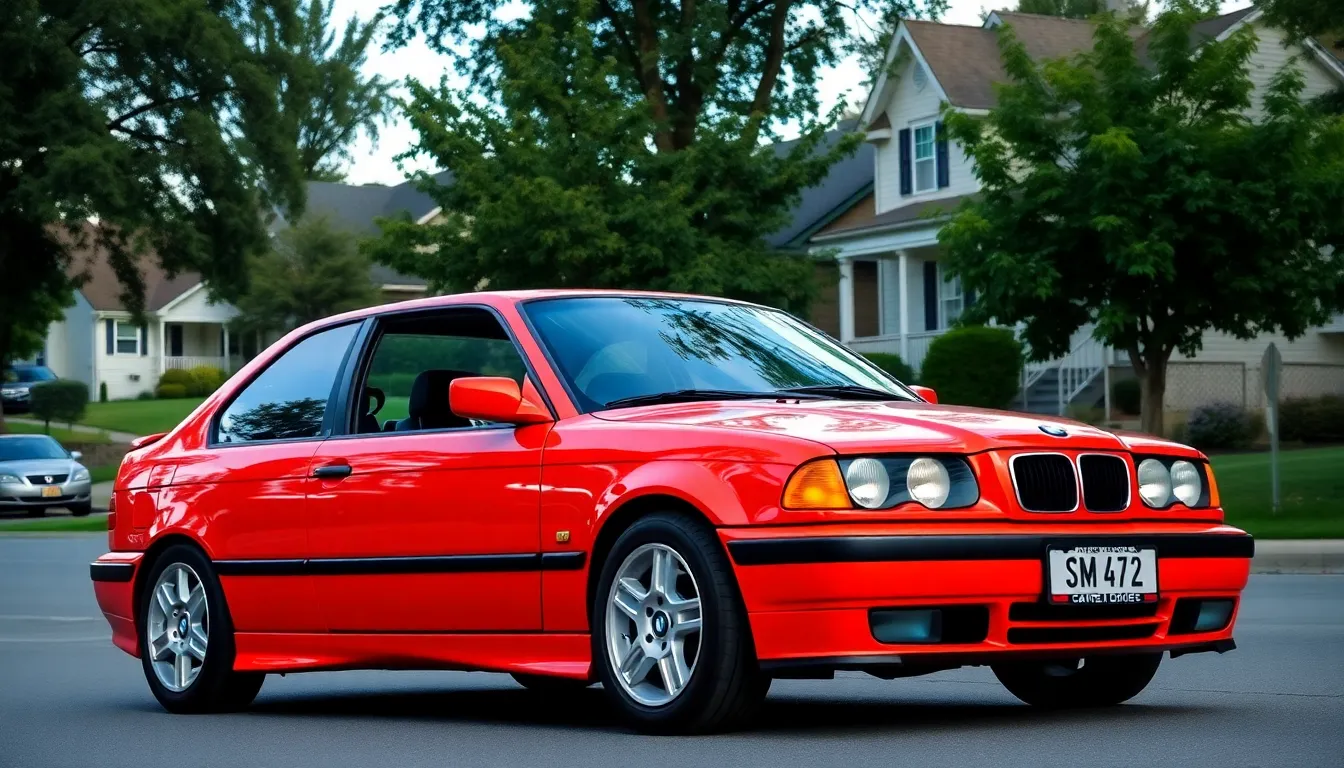
BMW E36 Compact ownership brings predictable maintenance patterns typical of 1990s BMW engineering. Understanding these reliability characteristics helps owners prepare for long-term ownership costs and potential repairs.
Known Problem Areas
Cooling system components represent the most frequent failure points in E36 Compact models. Plastic expansion tanks crack after 80,000 miles due to heat cycling, while water pumps typically fail between 60,000 and 100,000 miles. Radiators develop leaks at the side tanks around the 90,000-mile mark, particularly in vehicles with the M44 1.9-liter engine.
Electrical issues affect window regulators and central locking systems in vehicles over 15 years old. Window regulator motors burn out frequently, with passenger side failures occurring 40% more often than driver side units. Door lock actuators fail in cold climates, causing intermittent locking problems that affect security and convenience.
Suspension bushings deteriorate between 70,000 and 120,000 miles depending on driving conditions. Rear trailing arm bushings split first, creating handling inconsistencies and tire wear patterns. Front control arm bushings follow similar degradation timelines, affecting steering precision and wheel alignment stability.
Oil leaks develop at the valve cover gasket and oil pan gasket after 100,000 miles. These seepage issues rarely cause catastrophic failures but create maintenance cosmetic concerns. Transmission mount wear occurs around 80,000 miles, producing vibrations during acceleration and deceleration cycles.
Maintenance Requirements
Engine oil changes occur every 7,500 miles using BMW-approved 5W-30 synthetic oil specifications. We recommend reducing intervals to 5,000 miles for vehicles exceeding 150,000 miles to maintain engine longevity. Oil filter replacements accompany each service using OEM or equivalent quality components.
Cooling system maintenance includes radiator flushes every 60,000 miles and thermostat replacements every 80,000 miles. Expansion tank replacement becomes necessary every 70,000 miles as preventive maintenance, avoiding roadside failures. Water pump replacement typically coincides with timing belt service on applicable engines.
Brake fluid changes occur every 24 months regardless of mileage to prevent moisture absorption and component corrosion. Brake pad replacements vary between 30,000 and 50,000 miles depending on driving habits and pad compound selection. Rotor resurfacing or replacement accompanies pad changes when thickness measurements fall below specifications.
Transmission service involves fluid changes every 60,000 miles for automatic variants and 40,000 miles for manual transmissions. Clutch replacement becomes necessary between 80,000 and 120,000 miles in manual models, with driving style significantly affecting component lifespan. Differential oil changes occur every 60,000 miles using BMW-specified gear oil.
Timing belt replacement schedules differ by engine type, with M43 engines requiring service every 60,000 miles and M44 engines needing attention every 100,000 miles. Belt tensioner and idler pulley replacements accompany timing belt services to prevent component failures. Spark plug replacements occur every 30,000 miles for optimal engine performance and fuel economy maintenance.
Market Value and Collectibility
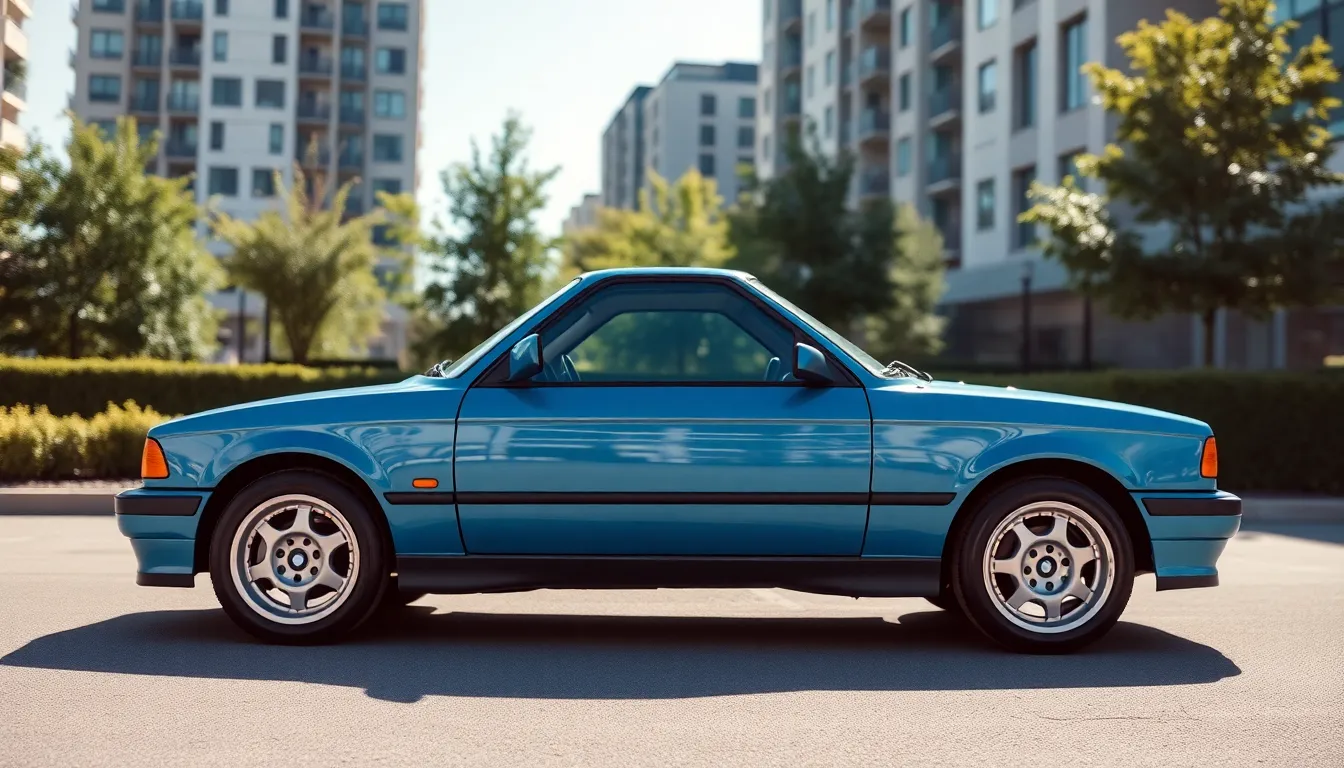
Market values for BMW E36 Compact models continue rising as enthusiasts recognize their significance within BMW’s heritage. Current prices range from $2,500 for high-mileage base models to $15,000 for pristine 323ti variants with documented maintenance records. Clean examples with the M44 1.9-liter engine typically command $4,000 to $8,000 depending on mileage and condition.
Price Ranges by Engine Configuration:
| Engine Type | Condition | Price Range | Typical Mileage |
|---|---|---|---|
| M43 1.6L | Good | $2,500-$5,000 | 120,000+ miles |
| M44 1.9L | Good | $4,000-$8,000 | 100,000-150,000 miles |
| 323ti 2.5L | Excellent | $8,000-$15,000 | 80,000-120,000 miles |
Collectibility factors center on original paint, complete service documentation and unmodified interiors. European examples with rare color combinations like Avus Blue or Cosmos Black show stronger appreciation rates compared to common silver or white variants. Manual transmission models consistently outperform automatics in both demand and resale values.
Investment potential appears strongest for 323ti versions equipped with the M52 inline-six engine. These performance variants represent only 15% of total E36 Compact production, making them increasingly scarce in excellent condition. Original wheels, intact trim pieces and functioning air conditioning systems add important value premiums.
Regional availability influences pricing considerably across different markets. German examples often feature better specification levels but command higher prices due to domestic demand. UK right-hand-drive models remain affordable alternatives for collectors seeking entry into E36 ownership. Eastern European markets offer the largest selection of rust-free examples at competitive prices.
Restoration costs typically range from $3,000 to $8,000 for comprehensive mechanical refreshes including cooling system overhauls, suspension rebuilds and interior refurbishment. Parts availability remains excellent through BMW Classic division and aftermarket suppliers, supporting long-term ownership viability.
Appreciation trends indicate 5-8% annual growth for well-maintained examples as the E36 generation gains classic status. Early production models from 1994-1995 show particular collector interest due to their connection to BMW’s compact car origins and distinctive styling elements not found on later variants.
Pros and Cons of Ownership
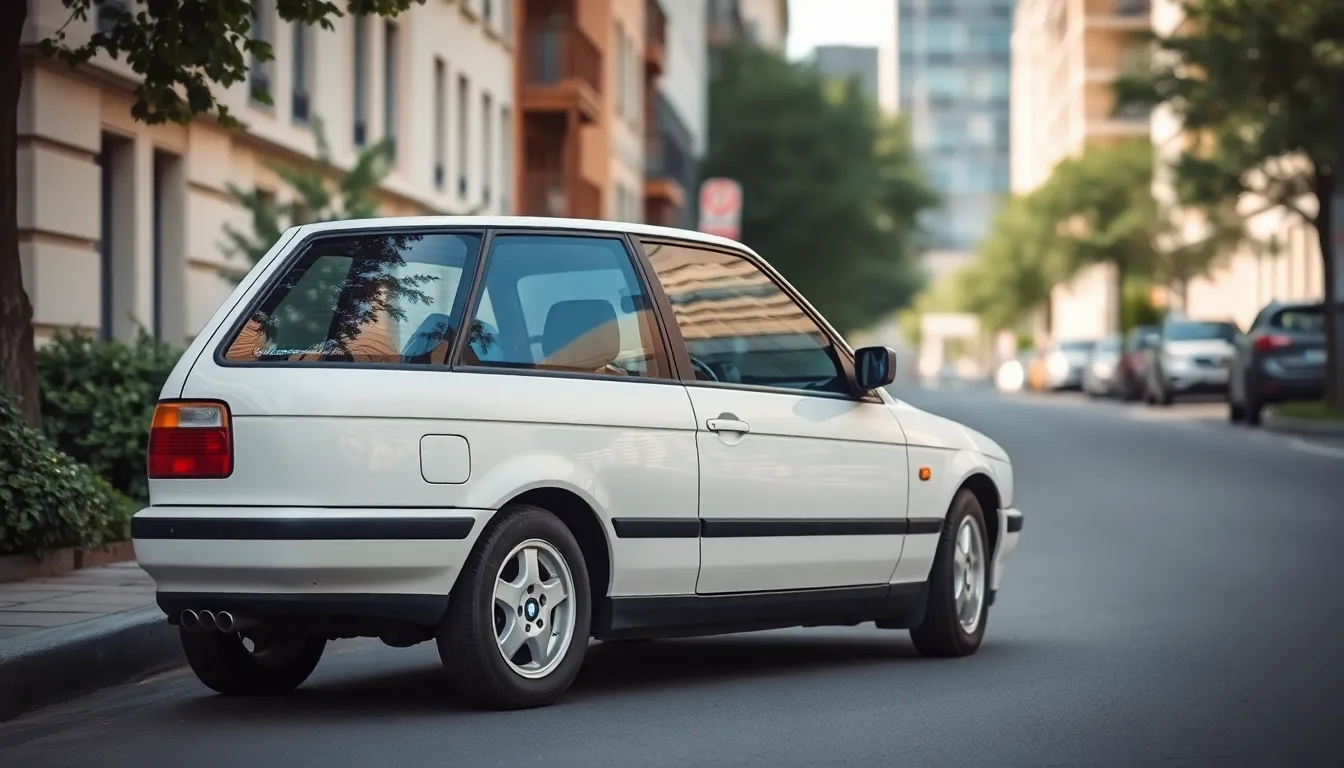
Ownership of the BMW E36 Compact presents distinct advantages that attract enthusiasts to this underrated model. Affordability stands as the primary benefit, with pricing ranging from $2,500 for high-mileage examples to $15,000 for pristine 323ti variants. Authentic BMW driving dynamics remain intact even though the shortened wheelbase, delivering the brand’s signature 50/50 weight distribution and precise steering feedback.
Maintenance costs prove reasonable compared to larger BMW models from the same era. Parts availability remains strong across European markets, with common components readily accessible through BMW dealerships and independent suppliers. Performance versatility accommodates various driving preferences, from the economical M43 1.6-liter producing 102 horsepower to the spirited M52 2.5-liter in 323ti versions generating 170 horsepower.
| Ownership Benefits | Exact Details |
|---|---|
| Entry Cost | $2,500-$15,000 depending on condition |
| Fuel Economy | 28-32 mpg across engine range |
| Performance Range | 102-170 horsepower options |
| Weight Distribution | Maintains BMW’s 50/50 balance |
| Parts Availability | Strong European supplier network |
Compact dimensions enhance urban maneuverability while parking remains effortless in tight spaces. Investment potential shows promise with 5-8% annual appreciation for well-maintained examples. Insurance premiums typically cost less than equivalent E36 sedans or coupes due to the model’s practical classification.
Drawbacks emerge through predictable maintenance requirements common to 1990s BMW engineering. Cooling system components fail regularly, requiring proactive replacement of radiators, water pumps, and expansion tanks. Electrical gremlins affect window regulators and central locking systems in higher-mileage examples.
Suspension bushings deteriorate over time, creating handling inconsistencies that demand attention. Oil leaks develop at valve cover gaskets and oil pan seals as vehicles age beyond 150,000 miles. Interior wear patterns show accelerated deterioration in high-use areas like seat bolsters and door panels.
Limited cargo space restricts practicality compared to modern hatchbacks. Rear passenger comfort suffers due to the shortened wheelbase and compact proportions. Finding pristine examples becomes increasingly difficult as many units suffered from deferred maintenance or modification.
Regional availability varies significantly, with German market examples commanding premium pricing due to domestic demand. Restoration costs can escalate quickly when addressing multiple systems simultaneously, potentially exceeding the vehicle’s market value for neglected examples.
Conclusion
The BMW E36 Compact represents everything we love about accessible enthusiast cars. It’s a model that doesn’t demand compromise between practicality and driving pleasure.
We believe this compact BMW will continue gaining recognition among collectors and enthusiasts alike. The combination of rising values and decreasing availability makes now an ideal time to consider ownership.
Whether you’re seeking your first BMW or adding to an existing collection the E36 Compact delivers authentic driving dynamics at a reasonable price point. It’s proof that great cars don’t always come in the most obvious packages.
For those ready to embrace 1990s BMW engineering the E36 Compact offers a rewarding ownership experience that’s becoming increasingly rare in today’s automotive industry.
Frequently Asked Questions
What is the BMW E36 Compact and when was it produced?
The BMW E36 Compact is an underrated entry-level BMW model produced from 1994 to 2000. Built on a shortened E36 platform, it was designed for younger buyers seeking an affordable premium compact car. Approximately 400,000 units were manufactured, featuring various engine configurations from 1.6L to 2.5L inline-six in the performance-oriented 323ti variant.
What engine options were available in the E36 Compact?
The E36 Compact offered three main engines: the M43 1.6L producing 102 hp (0-62 mph in 11.5 seconds), the M44 1.9L generating 140 hp (0-62 mph in 9.2 seconds), and the M42 1.8L with 138 hp (0-62 mph in 9.4 seconds). The range-topping 323ti featured a 2.5L inline-six engine for enhanced performance.
How much does a BMW E36 Compact cost today?
Current market prices range from $2,500 for high-mileage base models to $15,000 for pristine 323ti variants. Clean examples with the M44 1.9L engine typically cost $4,000-$8,000. European market prices range from €3,000 to €12,000, with well-maintained examples showing 5-8% annual appreciation, particularly early 1994-1995 models.
What are the common reliability issues with the E36 Compact?
Common issues include cooling system component failures, electrical problems with window regulators and central locking, deteriorating suspension bushings, and oil leaks at valve cover and oil pan gaskets. These are predictable maintenance patterns typical of 1990s BMW engineering. Regular maintenance including oil changes, cooling system care, and brake fluid changes helps ensure reliability.
Is the BMW E36 Compact good for driving enthusiasts?
Yes, the E36 Compact offers an authentic BMW driving experience with its maintained 50/50 weight distribution, precise rack-and-pinion steering, and balanced chassis. The shortened wheelbase enhances nimbleness while retaining predictable handling and cornering dynamics. It combines daily driving practicality with BMW’s signature performance characteristics at an affordable price point.
What makes the E36 Compact collectible?
Collectibility factors include original paint, complete service documentation, unmodified interiors, and rare color combinations. The 323ti variants show strongest investment potential due to increasing scarcity. Early production models (1994-1995) and well-maintained examples are particularly sought after, with appreciation trends indicating steady value growth among collectors and enthusiasts.

